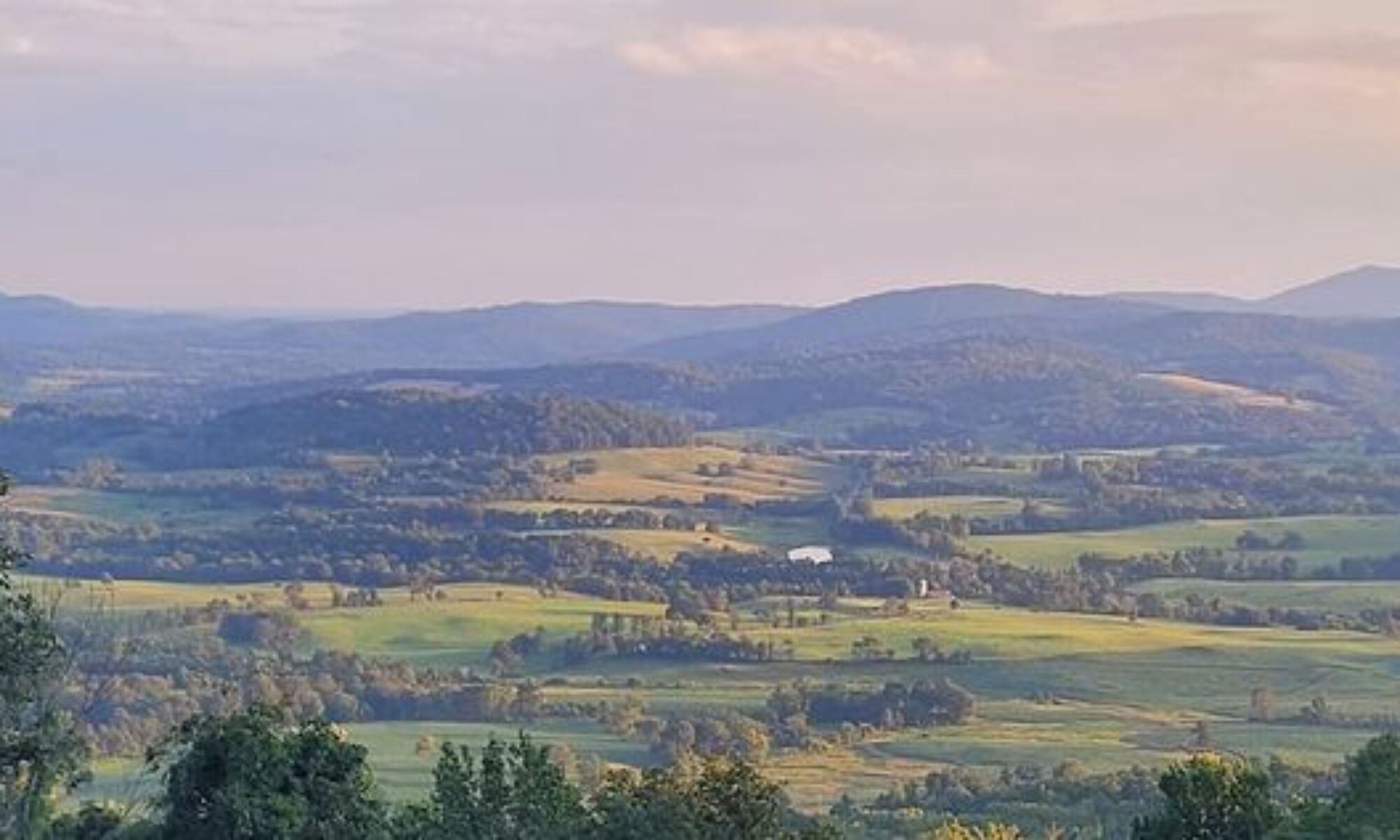The recent bruhaha over plastic straws in California has finally motivated me to present my experiences and opinions on the matters of Reducing, Reusing, and Recycling in the Age of Environmentalism. I have personal first-hand experiences that are a wee bit unique, and I have a few observations and ideas for being more efficient and less emotionally reactive to our environment.
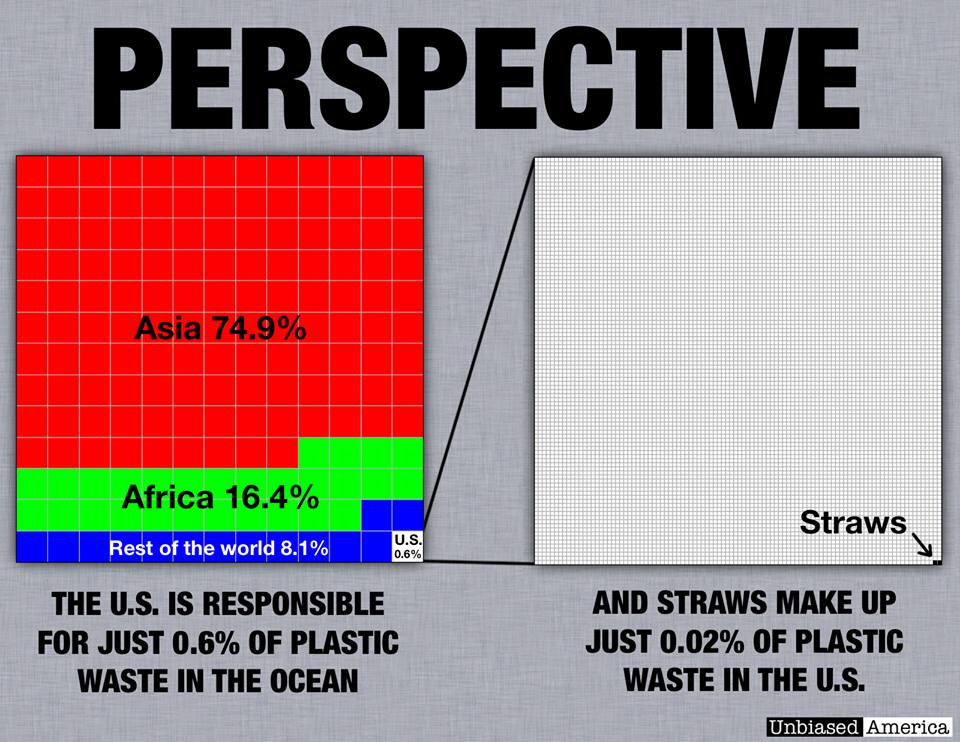
I believe that we, as a society, a nation, a people, and a civilization Must advance beyond the outdated idea that sequestering our garbage is the solution to our problems. Rather, I suggest that it is past time to modernize our ideas about consumerism, packaging, and recycling. All the energy and resources we spend on recycling bins, specialized trucks, separating facilities, and processing plants is at best perpetuating a multi-billion-dollar INDUSTRY, one that Will safeguard and protect itself (as the monster that it is), and is at Worst little more than snarky, smug shaming and virtue signaling.
When the concept of recycling was introduced back in the early 1970’s, “deposits” were introduced to pop bottles, and value was added to aluminum cans. Reclamation centers motivated down-and-out folks to gather what would otherwise be considered litter. What started out as a well-intended attempt to recover our ALUMINUM and lower the number of beer cans and soda bottles along our roads has morphed into a near-obsessive religion of separating and sequestering our metal, tin, aluminum, paper, cardboard (not the same thing!), plastics, glass, hair, lint, and soap scum (ok, I made that last one up…).
I acknowledge that it makes perfect sense, to a degree, to recycle Aluminum. Creating aluminum is extremely electricity-hungry and energy consuming. So much so, that I present that we ought not focus So much on the recycling of aluminum, but rather the progression AWAY FROM IT. Recent health studies have also indicated that aluminum in our food production may not be as innocuous as we once thought or hoped.
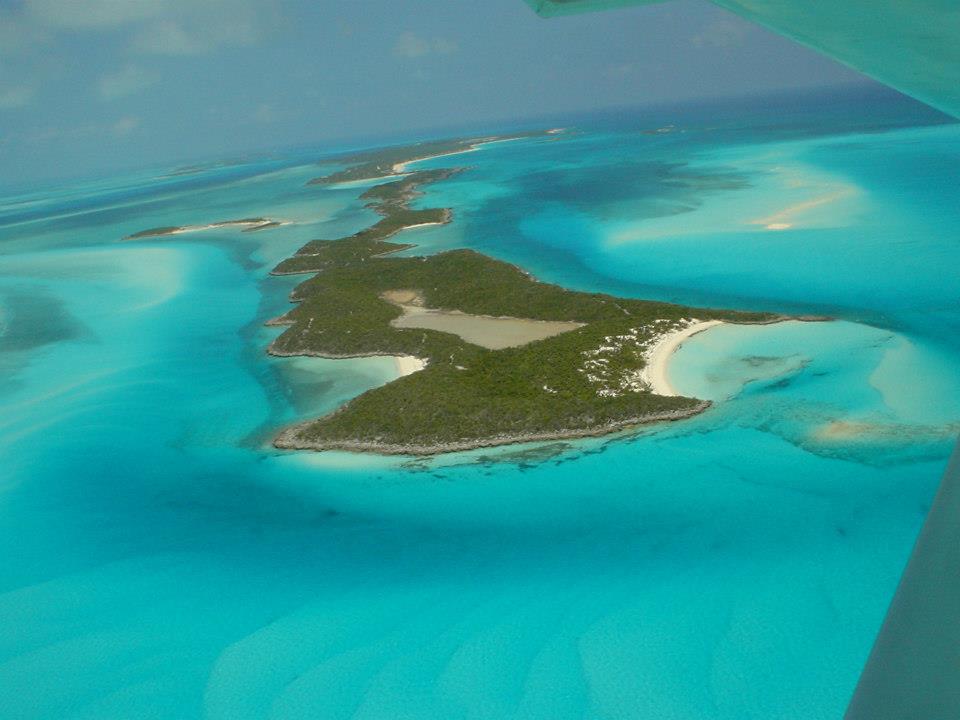
I offer an interesting anecdote I had some fifteen years ago. I was running Little Hall’s Pond Cay for Johnny Depp. The island is roughly 50 acres, some 75 miles south and east of New Providence (Nassau) in the Exumas, Bahamas. There is no grid to tie into—I generated our own electricity via solar, wind, hydrogen, a smattering of symbolic hydropower, and yes, backup diesel generators. I designed, installed, operated and maintained the power system(s), as well as the rain catchment and seawater desalination (reverse osmosis) plants, cisterns, and water transfer system. The water that came out of our tap had been ozone purified, particulate filtered, and finally Ultra Violet purified. I could demonstrate that the tap water showed a dissolved solid mineral content of no more than 130 parts per million. Evian and Fiji Water (Whuk! Ptui!!) has a dissolved mineral content of upwards of 860ppm. Not to mention the enormous carbon footprint involved (but more on that in a moment).
So, the Owner and a few guests were on island. One evening, we were all enjoying a languid sunset down at the Lanai. I noticed a member of the entourage standing with a confused look on her face and an empty Fiji Water bottle in her hand, gazing from one trash can to the next. I hopped up, and told her, “Drop it in the can on the left”. She did, and noticed all the paper products, dozens (hundreds) of other water bottles, and assorted trash.
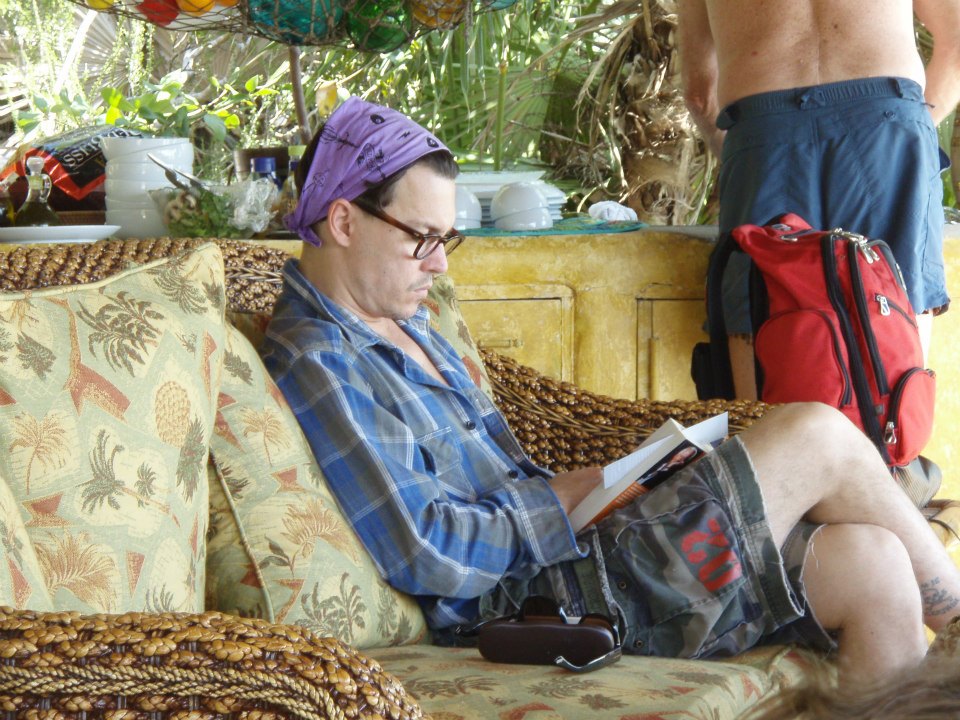
She asked me about our garbage plan. “Did we recycle?” “Oh, boy. Here we go.” I thought. I replied, “Well, we segregate our trash into three basic groups—Glass and Metal into one, Paper and Plastics into another, and food scraps into a third.” “OK, but what is your recycling plan?” she asked. “Well…. I take the food scraps, and compost them (as potting soil is precious and exorbitant down-island). I crush the cans and bottles, and about twice a week we head out into 10,000 feet of water and dump them overboard, where they flutter into the abyss. The plastic and paper, I recycle into SMOKE.” Needless to say, I suddenly found myself the centerpiece of a shit bouquet, surrounded by a dozen horrified Los Angeles starlets and cinematographers and sound engineers. J.D. had heard it all before, so he was chillin watching the sun hit the horizon, hoping for the mythical green-flash.
“You mean, you don’t Recycle these bottles? You don’t (somehow) send them to the (nonexistent) recycling plant in Nassau? You BURN them?? And you just dump the glass and metal into the OCEAN??” So, I told her (and them all), “First off, do you have ANY idea what it means to ‘send our recyclables to Nassau’? Used to be, for a while, when we would have a barge arrive with supplies, we would fire up the backhoe, and load all the accumulated glass and metal and plastic and garbage onto the now empty barge and send it to Nassau for ‘Proper’ disposal. Know what they did with it? Soon as the barge is off shore (sometimes in deep water, sometimes in 18’ of water), they drop the front gate down, and shove the entire works overboard. ALL of it. Including the plastic! I know this, because I’ve SEEN it, first-hand. Know what happens to the rare bits that DO reach Nassau? They get scooped up, taken to the landfill, and burned.”

“Now, a word about our specific circumstance. You flew into Nassau on a Private jet from Los Angeles. You then boarded a 157’ private diesel-powered yacht and spent two days noodling down to this Private Island. And I have to ship in, on a chartered barge from MIAMI, cases and cases of Inferior, Dirty, Plastic-tea FIJI water for you princesses to drink HALF of. You leave the half-consumed bottles (bottles that were SHIPPED or FLOWN all the way from the Island of FIJI!!) all over the place.
Our agent in Miami drives his Diesel Ford F-350 out to Costco, buys case after case of this crap, hauls it back to our chartered barge, where it is carried aboard. It then floats all the way to Nassau, where it clears customs, continues down here to the neighbor’s island, where I rendezvous with it in our supply boat.
I load it from the dock, into the boat, drive the twenty minutes back here, unload it onto the dock, load it into the diesel buggy, drive it to the warehouse, load it onto the shelving, pull it out for your arrival, stock all the minifridges on the island with this crap, all for you to waste half of it, then give ME grief for not RECYCLING the detritus of YOUR extravagance?? Seriously?” (to his credit, JD was now chuckling at the diatribe, enjoying his sunset)
Now that I’ve gotten THAT off my chest, allow me to propose some SOLUTIONS and ALTERNATIVES.
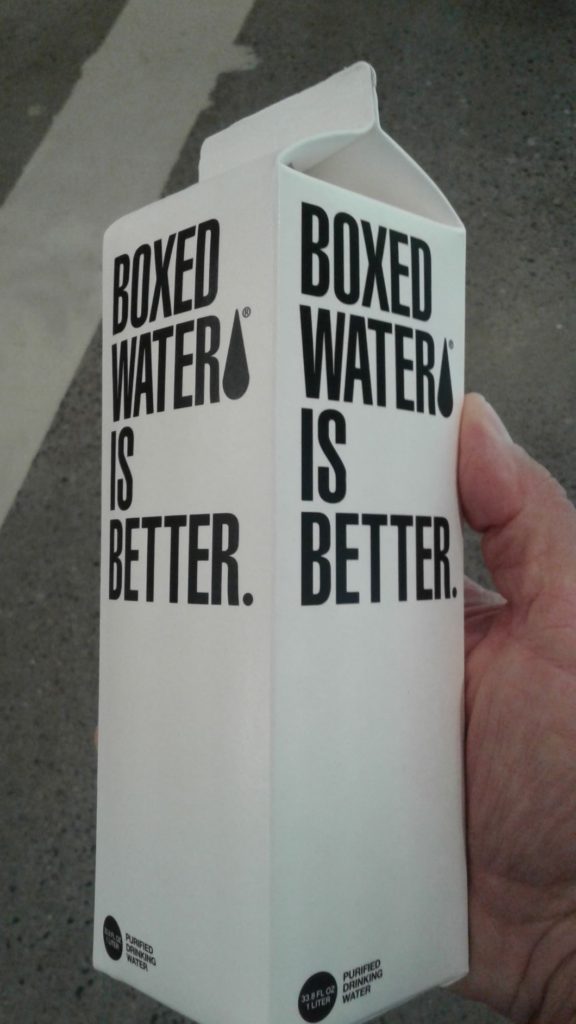
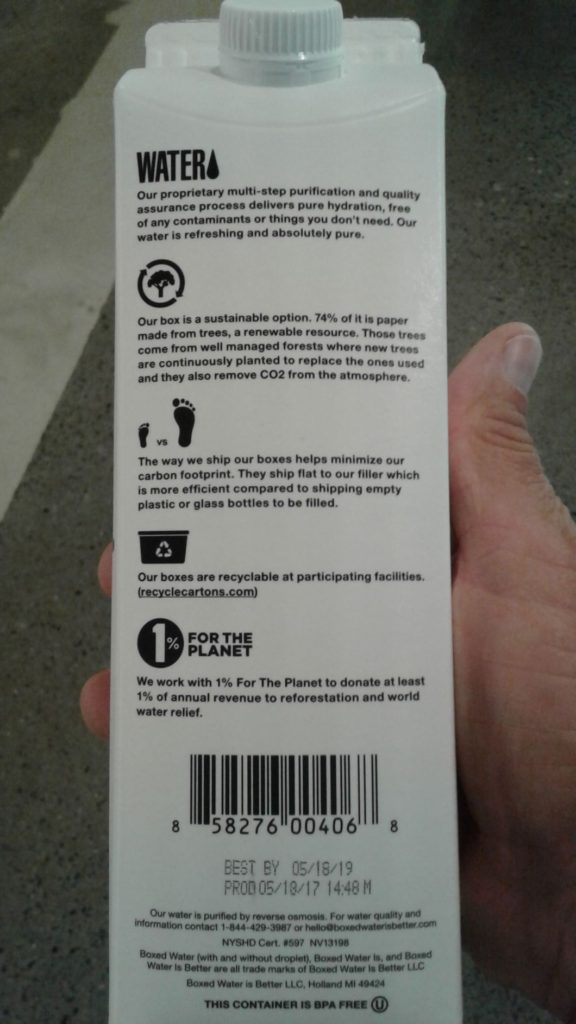
First off, we need to recognize Bottled Water as simultaneously the very best marketing campaign, and the best scam ever perpetrated against mankind. One great, huge leap toward mitigating the catastrophic environmental shit storm the 16-ounce plastic water bottle has unleashed against the planet is a rather new consumer product brilliantly called “BOXED WATER IS BETTER”. And it is. In myriad crucial ways. First off, is the packaging. When you produce bottled water, almost invariably your filling plant is in one place, and the bottle manufacturer is in another, sometimes thousands of miles away.
Well, those bottles are made (at great environmental impact) over HERE, then loaded onto 18-wheelers and trucked all the way over …THERE. Then filled, then trucked AGAIN to the distribution center, then to the point of sale. Boxed Water boxes are shipped from the manufacturing plant to the “bottler” FLAT. Shipped as such, they take up a Fraction of space. A lifetime of boxes can be shipped on One truck. Also, let’s not forget, these boxes are BOXES. They are made of Paper (well, ok., wax coated paper, and a small plastic cap). Also, as they are square BOXES, they take up 35% less space than bottles.
In other words, you can fit 35% more product in the same space, or the same quantity takes up 35% less space. And it’s cheap.
Also, on the issue of Water and how to make the most of it, I would like to discuss rainwater catchment. I find it completely comical that Americans consider rainwater catchment to be unsanitary, third-world, and generally “icky” (actual opinion voiced by a fellow Virginian). We have this concept that as rain falls, it is somehow inherently contaminated by the sky, hits the ground, sinks to indeterminate depths in the ground where it is magically cleansed and purified. It then sits in large underground reservoirs, just waiting for us to puncture its underground nirvana with a straw, and drink to our hearts content.
The overwhelming majority of rain falls as nearly distilled steam, cleaner than almost anything we can buy. Once it hits the ground, though, all bets are off. There, it mixes, mingles, and melts with grease, oil, feces, chemicals, fertilizers, poisons, every concoction known to and from the depths of man. It does seep through the topsoil and, hopefully, through at least ten feet of limestone where mmmmmost of these impurities are soaked up by the rock.
Alas, we have very little way of assuring the quality of what we suck out of the ground. And hence the chemical shitstorm of “treatment” we put our tap water through. If we capture our water BEFORE it hits and mingles with all these nasties, we can Far better “secure the supply chain”. Rainwater cisterns provide imminently BETTER water than treated municipal water. This is a no-brainer. I have LIVED on rainwater and reverse osmosis for over twenty years. It is simply better in every way.
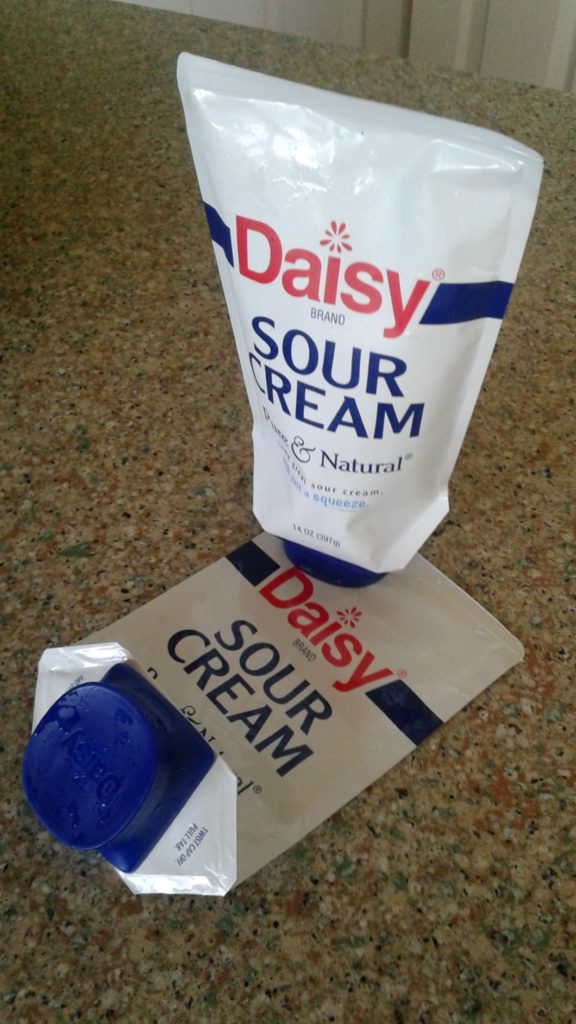
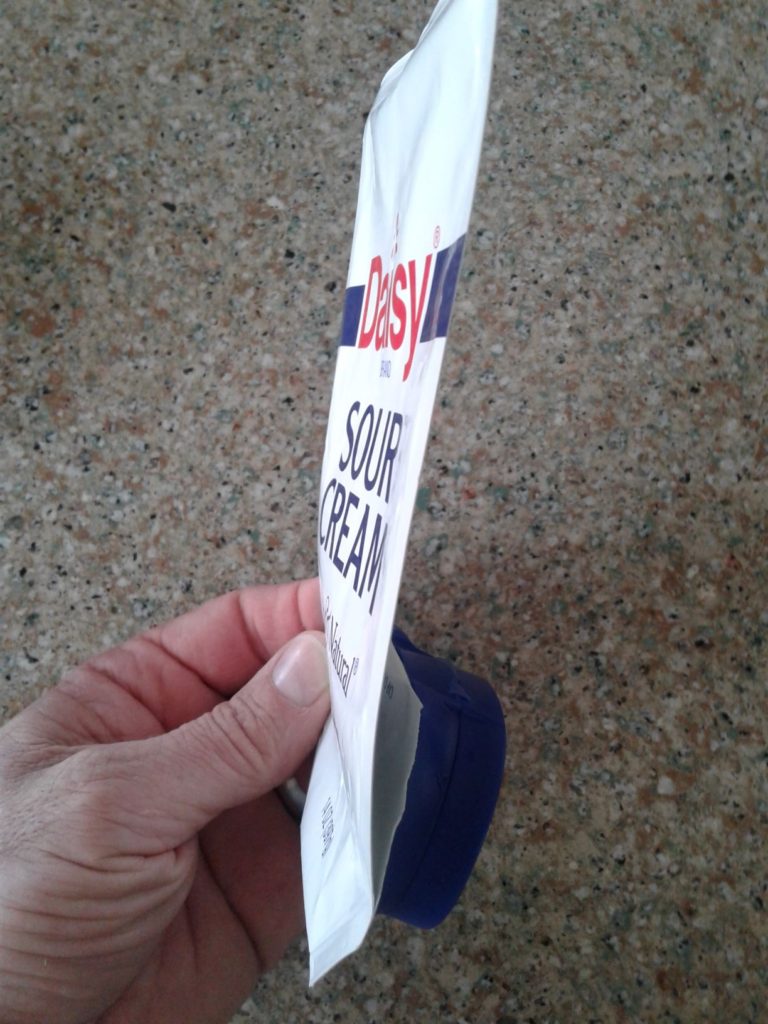
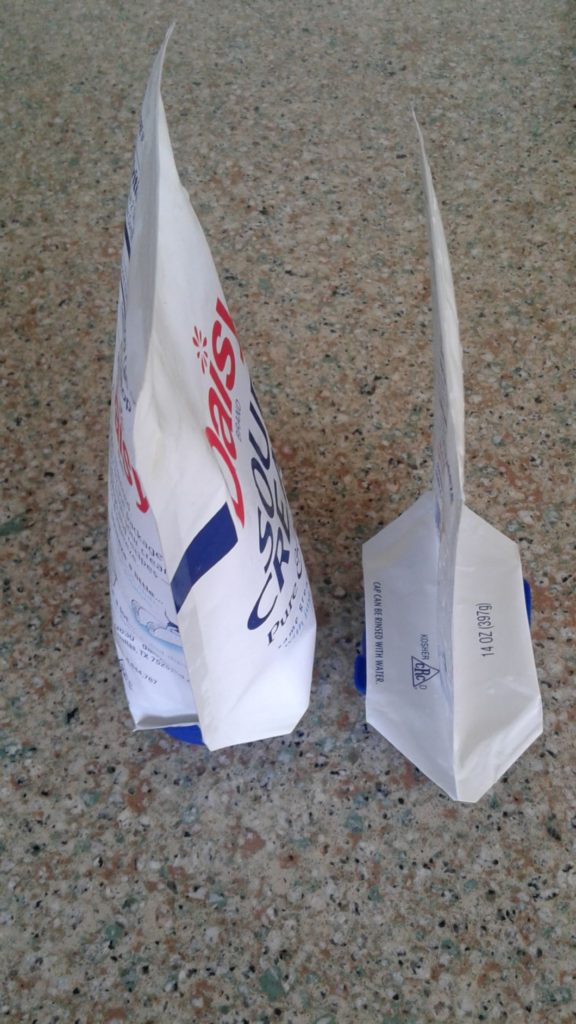
Another excellent example of innovative packaging is Daisy Sour Cream. They have made award-winning improvements in their packaging, both from the prospect of environmentalism and product quality. They have ditched the typical plastic tub, in favor of a squeeze package that sits on the lid, not unlike Heinz Ketchup. However, unlike the conventional plastic ketchup container (the only thing innovative about that is that it sits on its lid), the soft sided sour cream package collapses as you use the product. This keeps the remaining contents air-tight, and fresh as ever. The finished, empty package is flat as can be, and weighs darn near nothing. The concept that the younger generation will pay a minor premium for superior packaging is finally dawning on some producers!
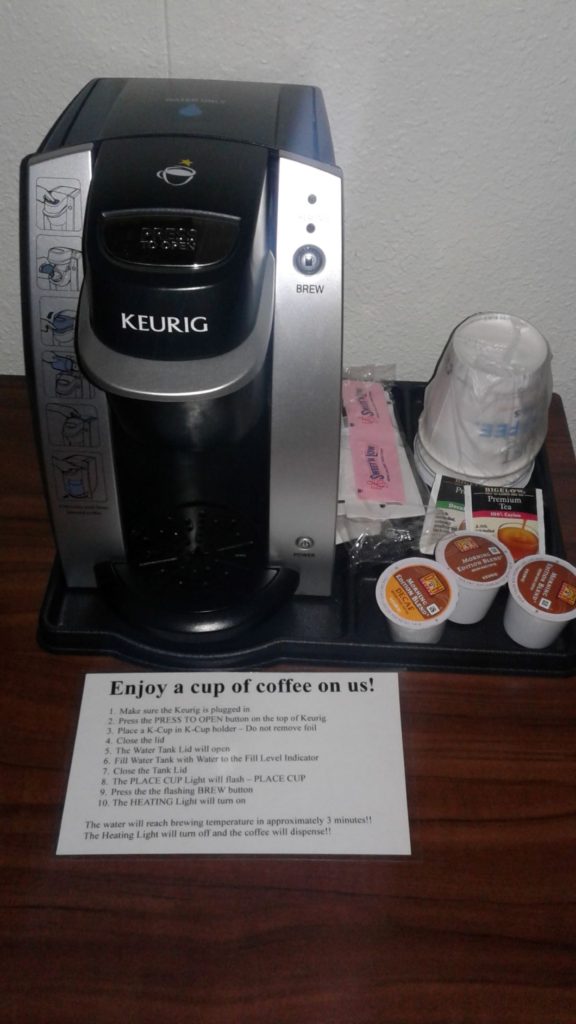
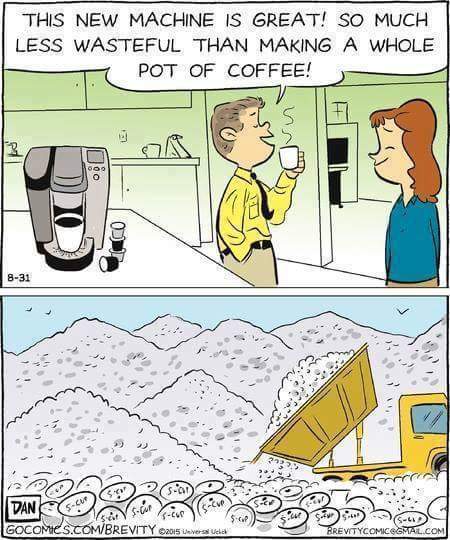
A horribly misguided indulgence that was originally promoted as efficient and environmentally friendly (!) is the Keurig. Not since Bottled Water has a scam this destructive and wasteful been unleashed upon guilty consumers desperate to virtue signal and “feel good”.
There are many problems with the Keurig. First, the coffee sucks. It just does. The machines are notoriously impossible to effectively clean. If you want your idealism smashed, I challenge you. Next time your Keurig breaks and mmmmust be replaced (and we KNOW it will!), deconstruct the broken one.
I don’t care how many times you ran Special Cleaner through it. It WILL. BE. a Seething cesspit of mold and smegma. These machines are filthy.
Lastly, and most importantly, the pods are stupidly expensive (they remind me of buying printer ink), and they Never go away. Billions of them now. And millions more every week. Filling landfills. Piling up. Forever. These are SO bad, they are SO toxic, that John Sylvan, the inventor of the system has sued to distance himself from this Frankensteininan disaster he spawned. He now spends his time and energy and money tithing and attempting to redeem himself to a humanity that will never forget his little contribution to the Great Pacific Garbage Patch.
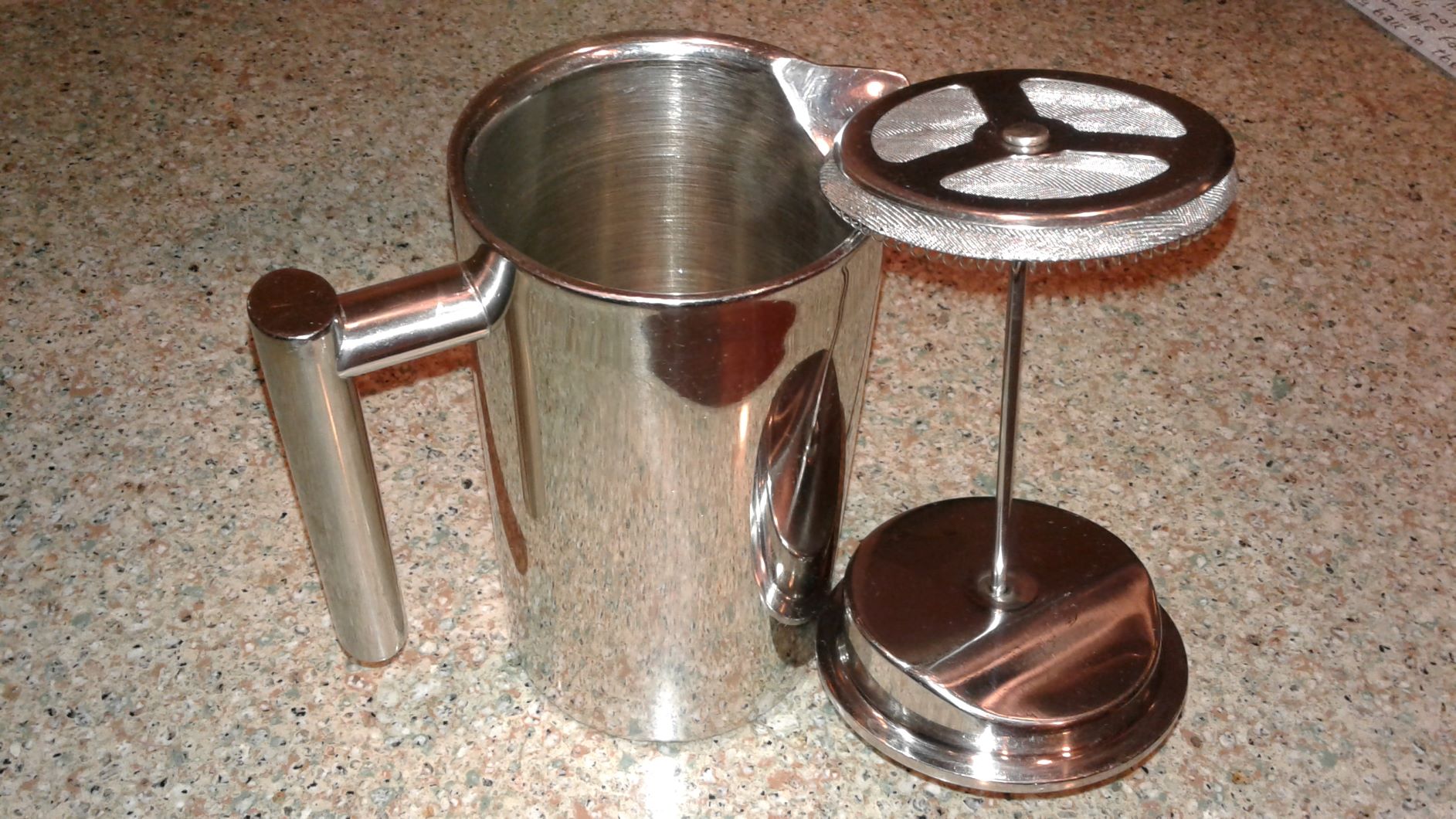
Fortunately, the Anti-Keurig has been around for millennia, is efficient, economical, imminently better for the environment, and produces literally the best coffee I’ve ever had.
All Hail the Simple French Press, or Bodum. Ours is stainless steel (I favor the stainless over the glass beaker-type, as those are fragile, in my opinion), and has worked flawlessly for a decade now. And it’s CLEAN. Simply boil a kettle of water, add three spoons of coffee, add water, and enjoy.
Now as for the whole ridiculousness of California banning STRAWS to “benefit the environment” (yeah, right). Straws account for a whopping .002% of all plastic waste in our oceans and landfills. Absolutely insignificant.
“Well, oughtn’t we start SOMEWHERE?” one may ask. Indeed. But howabout somewhere that MATTERS? Why must we waste time and energy huffing and puffing about something so insignificant? Are we that desperate to “Feel Good”? Or are we just too afraid to effect change that will make a Real difference?
What’s my problem with the absurdity about straws? First off, the statistic of “500 million straws used every day in America” is abject bullshit. This unchallenged figure came from a bored nine-year old’s pet science project (mind you, not a “nine-year-old study”, but a silly little science project from a Nine-Year-Old Boy!).
Also, fueling public outrage and faux concern was a viral video of a turtle with a straw up it’s nose, being saved by good Samaritans. What’s more, the figure came from a handful of phone calls he made in 2011! Now, discount this fine, in-depth scientific method or not, there are some irrefutable facts that are NOT open to opinion or interpretation.
As much as 46% of the oceans plastic pollution is discarded, lost, orphaned fishing nets and equipment. And much of that equipment goes on fishing and killing, all to waste. Plastic water bottles, bags, and industrial dunnage make up the overwhelming majority of the rest of the pollution. The aforementioned Boxed Water would go a far way to alleviating this pollution. Especially when this leads to further acceptance and utilization of better, more efficient and biodegradable packaging. It seems Public Acceptance is the elusive Holy Grail.
In 1996, I sailed from Fort Lauderdale to New Zealand. The trip took six months. In the middle of the Pacific Ocean, aboard an 86′ Sloop, I drew the short straw (no pun intended). Overboard I went, with diving knife in hand, to cut away the fishing net that had gotten tangled in the keel and running gear.
The day was flat calm, the sunlight was brilliant, with rays of light that stretched off into the abyss. The net was so long it extended down from the keel, and floated away behind the boat, out of sight in both directions. Cutting it away took the better part of an hour.
Having lived on private, completely off-grid and self-reliant islands for much of the last twenty years, I can attest to the practicality and efficiency of many forms of “Alternative Energy”. I have first-hand experience designing, installing, maintaining and repairing solar, wind, hydrogen, hydroelectric, and diesel generators.
I have found windmills to be woefully wanting. They are loud, they are very high maintenance, and when they fail, they do so with enormous enthusiasm. I’ve seen them fling apart, over a thousand-yard debris field. And I’ve heard them whoosh whoosh whoosh day in and day out, to the point of distraction.
Solar panels just…. sit there. Silently. Providing power. Yes, I will acquiesce that, when the sun ain’t shining, usually the wind is blowing, and wind will blow at night. So, I’ve long held that a pragmatic system does integrate back-up or supporting wind power. But the Solar is, by far, the way to go. This ought to be integrated into Everyone’s home. It makes sense.
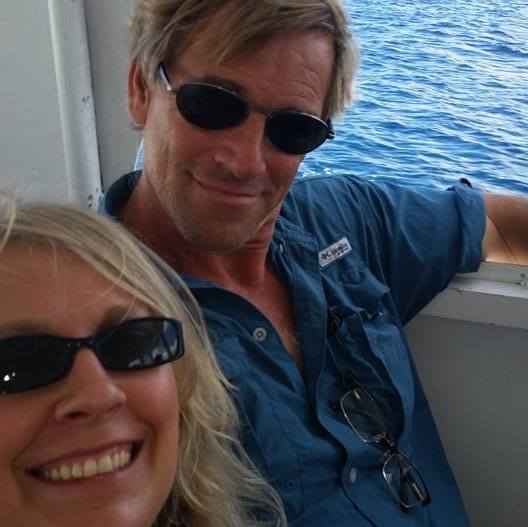
A caveat about grid-tie solar systems. We, Debbie & I, lived in the British Virgin Islands for a while. They had no ability or means to grid-tie solar systems into their power grid. The power costs were $0.24 per kilowatt hour. Compare this to Virginia Powers rates of approximately $0.11 per kilowatt hour, that seems rather steep.
However, take a gander at Saint Thomas. Just ten miles away, they DO have solar grid-tie. And they’ve promoted it. So much so, that their grid had maxed out on panels. They couldn’t take any more customer supplied power. They were at capacity. The panels stretched across the horizon, as far as the eye could see, and atop every single building.
Now, this would sound like a Great thing. Except for the insatiable nature of mankind. The Virgin Island power company took the position that, “We don’t care HOW much power you people are providing. WE aren’t going to EVER lower our budget, accept less money per month. We will simply increase the rates; we WILL get the same amount of MONEY from you, regardless of How much power we actually have to Produce!!”
Their power rates are/were a whopping $0.44 per kilowatt hour! And that was with acres and acres and thousands and tens of thousands of panels, across the horizon! Ahhhhahahahaha! Suckers.
Don’t let THAT happen here!
–Chris Cloud
